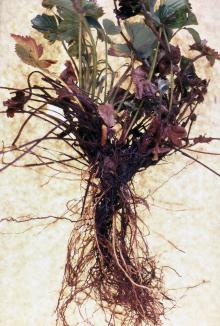See:
Apple (Malus spp.) - Replant Disease
Strawberry (Fragaria spp.) - Charcoal Rot
Cause A complex interaction of many fungi, nematodes, and poor soil characteristics. Organisms or factors involved in one area may not be involved in others. Fungi associated with black root rot symptoms are Rhizoctonia fragariae, Paraconiothyrium fuckelii, Cylindrocarpon spp., Pilidium lythri (formerly Hainesia lythri), Idriella lunata, Pyrenochaeta sp., and Pythium spp. Research in Oregon in the 1930s and 1940s implicated Rhizoctonia sp., Fusarium spp., and Ramularia spp. with root rot of strawberry. (It is interesting that the authors of the original description of I. lunata note its similarity to Ramularia.) Winter injury to roots also reportedly encourages infection by Fusarium sp. and Cylindrocarpon spp.
Some of these organisms are native soil fungi and survive indefinitely in soil. Root-lesion nematodes are frequently involved in root rot diseases such as black root rot. Consider that residual populations of root-lesion nematodes may be high in soils previously planted in legumes. Plants growing in sterile but saturated soil also will develop a black root rot. In addition, black roots can occur when roots dry out during transplanting.
Symptoms Symptoms include black discolorations on roots; the entire root or all but the core often darken, look unhealthy, and lack new growth. Foliage is reduced in size, has poor color, and wilts in warm weather. Although many roots rot away completely, they lack the red core discoloration typical of red stele.
Cultural control
- Plant certified stock on well-drained fertile soil adapted to strawberry production.
- While planting, keep roots from getting dry, and set plants at the proper depth.
- Use long crop rotation in commercial plantings; include grasses and grains in the rotation.
- Preplant soil solarization has been helpful in reducing populations of certain soilborne pathogens and weeds in western Oregon. Place clear plastic (preferably anti-condensation film) directly on smooth, rototilled ground, which has been irrigated to field capacity and then allowed to drain for 1 or 2 days. Bury the edges of the plastic to trap the heat. Solarize for 4-6 weeks (or longer) during the hottest part of the summer, beginning in early- to mid-July. Use in combination with other techniques.
- Anaerobic Soil Disinfestation may be helpful even in the PNW. First rice bran is incorporated into the soil followed by irrigation to near field capacity. Then place clear oxygen impermeable plastic (such as anti-condensation film) on the prepared ground. This summer treatment needs to reach soil temperatures of 90°F. Use in combination with other techniques.
- Do not plant strawberries on land with a recent history of black root rot.
- Plants with black root rot do not recover and should not be renovated.
Chemical control Preplant fumigation.
- Basamid G. Avoid application when soil is over 90°F. Do not apply within 3 to 4 feet of growing plants. 5-day reentry Restricted-use pesticide.
- Telone C-17 at 27 to 41 gal/A broadcast on mineral soils. Allow 2 to 3 weeks between application and planting or until odor leaves the soil. Do not treat extremely heavy soils. 5-day reentry. Restricted-use pesticide.
- Vapam HL at 37.5 to 75 gal/A. Immediately roll the soil and follow up with tarps or a light watering. May use through an irrigation system. 5-day reentry. Restricted-use pesticide.
Postplant applications - Based on a few field observations in the PNW, when Aliette (Group P7 fungicides) are used to control red stele, there also appears to be a reduction in root damage from some of the fungi in this complex. Also, a combination of azoxystrobin (group 11 fungicide) plus potassium phosphite (group P7 fungicide) helped slow black root rot decline in Michigan.
- Abound at 0.4 to 0.8 fl oz/1,000 row feet. Do not apply with silicone-based surfactants. May be applied on the day of harvest. Group 11 fungicide. 4-hr reentry.
- Agri-Fos at 1.25 to 2.5 quarts/A. Group P7 fungicide. 4-hr reentry. WA only.
- Aliette WDG at 2.5 to 5 lb/A. Do not use with adjuvants. Apply when plants resume growth in spring; continue at 30- to 60-day intervals. Apply no more than twice in spring and twice in fall. Can be applied on day of harvest but with a 12-hr preharvest interval. Do not apply within 30 days of harvest in British Columbia. Group P7 fungicide. 12-hr reentry.
- Fosphite at 1 to 3 quarts/A. Do not use copper products within 20 days of treatment and do not use spray adjuvants. Group P7 fungicide. 4-hr reentry.
- Monterey Garden Phos at 2 to 6 teaspoons/gal water as a foliar spray. Group P7 fungicide. H
- OxiPhos at 2.5 to 5 quarts/A as a foliar spray. Group P7 fungicide. 4-hr reentry.
- Phostrol at 2.5 to 5 pint/A. Group P7 fungicide. 4-hr reentry.
- Rampart at 1 to 3 quarts/100 gal water/A. Group P7 fungicide. 4-hr reentry.
References Miles, T. D., Glass, B. W., Sysak, R. W., and Schilder, A. C. 2018. Post-plant strategies for management of black root rot-related decline of perennial strawberry fields. Crop Protection, 104:78-85.
Pinkerton, J.N., Ivors, K.L., Reeser, P.W., Bristow, P.R., and Windom, G.E. 2002. The use of soil solarization for the management of soilborne plant pathogens in strawberry and red raspberry production. Plant Disease 86:645-651.
Rahman, M., Islam, T., Jett, L. and Kotcon, J. 2023. Probiotic Bacteria, Anaerobic Soil Disinfestation, and Mustard Cover Crop Biofumigation Suppress Soilborne Disease and Increase Yield of Strawberry in a Perennial Organic Production System. Plant Disease, 107:2490-2499.




